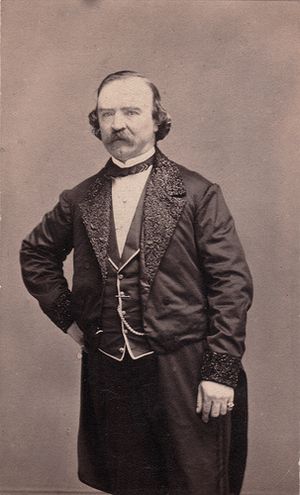John Henry Anderson facts for kids
John Henry Anderson (1814–1874) was a famous Scottish magician. He helped change magic from street acts into big theatre shows. Anderson wanted to entertain and amaze his audiences with his performances.
Contents
Early Life and Career Beginnings
John Henry Anderson was born in The Mearns, Scotland. He became an orphan when he was ten years old. At age sixteen, in 1830, he started acting with a traveling theatre group. By the time he was seventeen, he began performing magic tricks.
In 1837, when he was twenty-three, Anderson performed at the castle of Lord Panmure. Lord Panmure liked his show so much that he supported Anderson. This helped Anderson create his own touring magic show. This show traveled around for three years.
In 1840, Anderson settled in London. He opened his own theatre called the New Strand Theatre. It is said that the famous writer Sir Walter Scott gave him his stage name: The Great Wizard of the North.
Becoming a Famous Magician
Anderson became very successful because he was great at advertising his shows. His performances were popular and thrilled his audiences. He believed in giving back to the community and was an expert at showmanship. This made him one of the first magicians to become famous worldwide.
Anderson believed that magicians should always entertain. He would remove any trick from his show if the audience did not love it. He was well-known for performing the bullet catch illusion many times. He did not invent this trick, but he made it very popular. Other magicians even copied his version.
Anderson is also known for being the first magician to pull a rabbit out of a tophat on stage. This trick had been done in different ways before. However, Anderson was the first to perform this classic trick in a theatre show.
Family Life and Challenges
In 1842, Anderson married Hannah Longherst from Aberdeen. She was an assistant in his magic show. Their son, John Henry Jr., was born the next year. Anderson had two daughters, Helen and Alice, who also helped in his shows. They later became successful magicians themselves.
In 1845, Anderson opened his second theatre, the City Theatre in Glasgow. Just four months after it opened, the theatre burned down. Anderson lost a lot of money because of this fire. His friends in show business helped him. He was able to start a new show at London's Covent Garden Theatre in 1846.
The next year, he toured Europe. He traveled to places like Hamburg, Stockholm, and St. Petersburg. In St. Petersburg, he met Czar Nicholas I. The Czar even asked Anderson to perform a special show for him.
World Tours and Rivalries
In 1849, Anderson returned to London. He performed for Queen Victoria and Prince Albert. The next year, Anderson went on a big tour. He visited America, Canada, Australia, and Hawaii.
When he came back to Britain, Anderson found he had a rival. This was another magician named Robert Houdin. Robert-Houdin's magic tricks were copied by his mechanic, Le Grand. Many of these copied tricks ended up with other magicians like Anderson. It is not known how Anderson got these tricks. However, he did perform them even though he knew Robert-Houdin had invented them.
In 1853, Anderson returned to America and performed in Boston. He had a trick where he gave different drinks to the audience. This caused some discussion about rules regarding drinks in the city.
In 1859, Anderson started another world tour. In 1862, his son John Henry Jr. left his father's show. He started his own career as a conjuror. This caused a disagreement between them, and they never spoke again. Anderson returned to England in 1864, owing a lot of money. He went on one more tour in 1866.
John Henry Anderson died in 1874 in Darlington, England. He was buried next to his mother in Aberdeen. The famous magician Harry Houdini was born the same year Anderson died. Houdini admired Anderson greatly. In 1909, Houdini even paid to have Anderson's gravesite taken care of.
Exposing Spiritualism
In 1854, Anderson held a farewell show in Aberdeen. The show was so successful that it made him decide not to retire. Instead, he started to focus on showing how mediums and spiritualist tricks were done. He used his daughters in his shows to copy spiritualist effects. Anderson was one of the magicians who exposed the tricks of the Davenport brothers.
His show played at the Lyceum in London. Then it moved to Covent Garden in 1855. The next year, after a big performance, the theatre caught fire. All of Anderson's magic props were destroyed. This caused him to lose all his money for the second time in his career.
Anderson believed that spiritualism was a "delusion." He said it had caused many people to become confused in the United States.
Later Use of His Stage Name
Between 1879 and 1881, a magician named Philip Prentis Hind (1844–1920) started using "Professor Anderson" as his stage name in Australia. He presented himself as the person who would continue the legacy of the original Wizard of the North. His show included his wife, Louisa, who acted as a clairvoyant.
Images for kids



